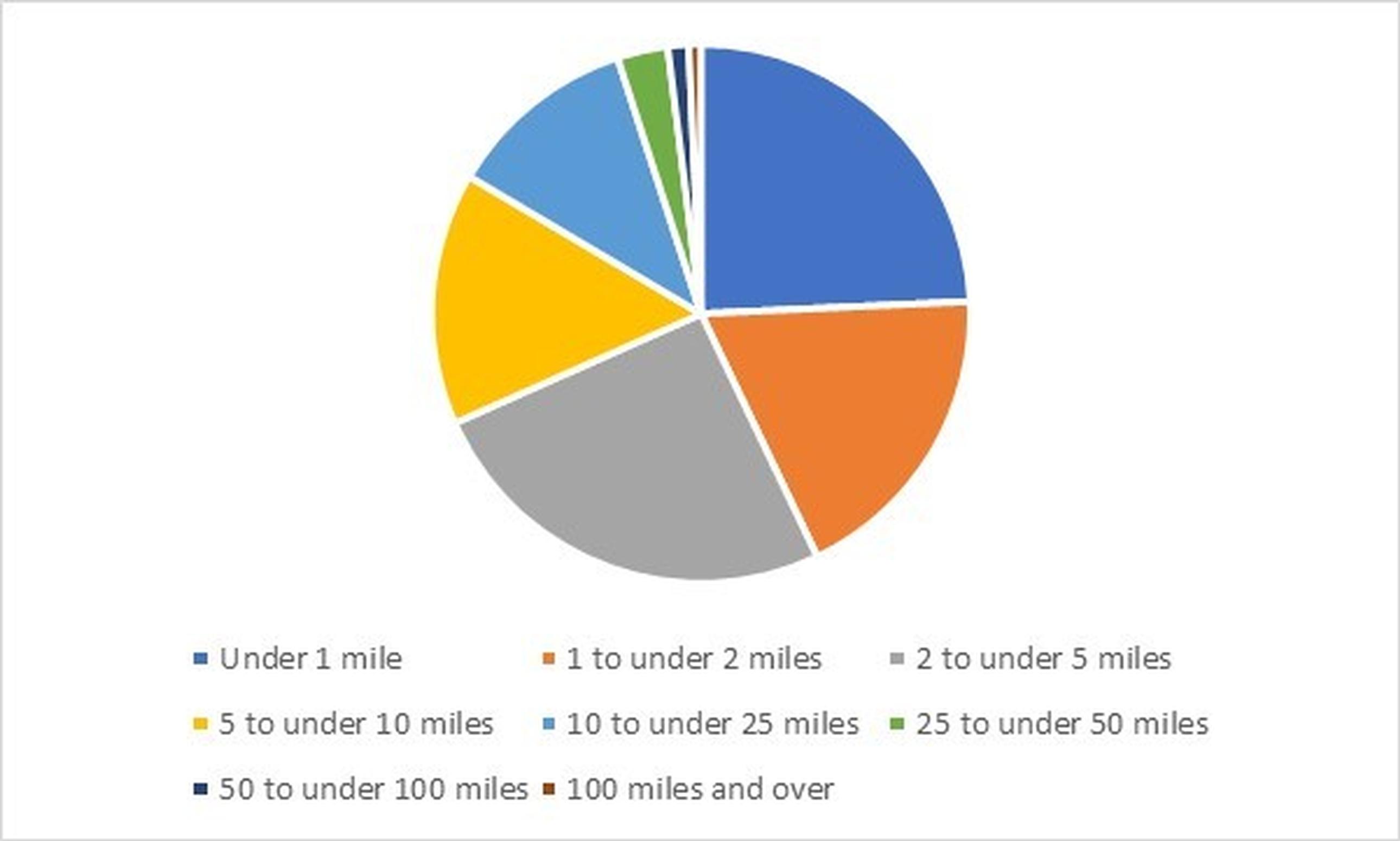

In this age of mobility we sometimes forget how local most of our journeys actually are. The latest English National Travel Survey reminds us that the majority of journeys we make are very local indeed (Fig 1). Of the average 953 trips we make each year, less than 2% are over 50 miles in length while 43% are less than two miles (Fig 2).
The majority of these local trips are walked, probably the most overlooked form of transport there is. However, even for these very local trips almost a quarter are undertaken by car drivers, just 3% by bus and only 2% by cycle.
It’s also no surprise that the more built up an area is, a higher proportion of short trips are made as more facilities are within closer proximity. In London, for example, 48% of trips are under two miles and just over 400 trips a year are longer than that. On the other hand, in rural villages only 25% of trips are less than two miles long with nearly 800 trips longer, double the number in London.
At the same time as publishing the National Travel Survey, the DfT also published detailed statistics on walking and cycling trips by local authority area. These show a considerable variation between urban areas with regards to the propensity to walk and cycle for non-leisure or exercise purposes.
Residents of inner London boroughs are the most likely to walk regularly followed by those in Brighton, Norwich and Oxford, with more than 30% walking at least three times a week. This is almost double the number in Warrington (Fig 3). It will come as no surprise to anyone that residents of Cambridge and Oxford have the highest cycling rates. York is the only other area achieving more than 10% of adults cycling at least three times a week.
The question for policy makers and transport planners is why do the residents of Southampton and Portsmouth achieve twice the cycling rates of those in Brighton and Nottingham, and why do 20% more people walk regularly in Manchester compared with the residents of Birmingham?
A high proportion of the trips we make are local and this has probably increased during and following lockdown. The benefits of fewer vehicles on the road during the lockdown period were clear for all to see. And I mean that literally; as air quality improved, the pollution haze that covers many of our urban areas lifted. There was a massive uplift in cycling, which while still higher now than pre-lockdown has to a significant degree melted away.
What would our urban areas be like if all reached the same cycling use as York and we walked as frequently as the residents of Manchester? A quick ‘back of the envelope’ calculation suggests it could lead to a reduction of a third in short car trips as well as decreases in the use of bus and taxi/minicabs. However, while the benefits of such a reduction in car traffic, in terms of improving peoples’ health both via reducing air pollution and increased physical activity, would be welcome, it is not going to have much impact on overall car use.
This is because only 3% of total car mileage is made up of trips of less than two miles. To make a material impact on car traffic it is journeys of 2 - 5 miles that need to be attracted to more sustainable modes of travel or we need to make better use of our local facilities. The trend over the last decade is that we are making fewer trips overall, but each trip is getting longer. Commuting, education, and shopping trips are getting longer and even our friends and family seem to live further way than before.
The country needs to reach Cambridge’s take up of cycling and we need to revert to using our local facilities more (if they haven’t already closed down) before we start to see any material change in road traffic.
John Siraut is director of economics at Jacobs. Email: john.siraut@jacobs.com
For more analysis on post Covid travel behaviour, see John Siraut’s presentation at the Clearer Roads, Cleaner Air webinar on the Landor LINKS YouTube channel: https://tinyurl.com/y533qod6
TransportXtra is part of Landor LINKS
© 2026 TransportXtra | Landor LINKS Ltd | All Rights Reserved
Subscriptions, Magazines & Online Access Enquires
[Frequently Asked Questions]
Email: subs.ltt@landor.co.uk | Tel: +44 (0) 20 7091 7959
Shop & Accounts Enquires
Email: accounts@landor.co.uk | Tel: +44 (0) 20 7091 7855
Advertising Sales & Recruitment Enquires
Email: daniel@landor.co.uk | Tel: +44 (0) 20 7091 7861
Events & Conference Enquires
Email: conferences@landor.co.uk | Tel: +44 (0) 20 7091 7865
Press Releases & Editorial Enquires
Email: info@transportxtra.com | Tel: +44 (0) 20 7091 7875
Privacy Policy | Terms and Conditions | Advertise
Web design london by Brainiac Media 2020
John Siraut
John Siraut
Economist specialising in the wider economic and social impacts of transport. Worked on Crossrail, Heathrow, London Gateway Port, light rail and tram schemes, buses, roads and parking. Also undertake economic research into areas such as housing, retail, street markets and regeneration generally. Chair of governors at an inner-city London school and a member of the Institute of Economic Development London executive. Specialties: Transport economics, economic development, economic research